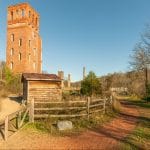A Brief History of Spartanburg
 A treaty with the Cherokee Indian Nation in 1753 opened up the area for settlers. The county formed in 1785 and got its name from the Spartan Regiment, a local militia unit that fought in the Revolutionary War. The county has grown from a frontier trading post and later a major textile center to an important and diversified manufacturing center with more than 500 manufacturing firms. Spartanburg County is an international business center with a high per capita foreign investment and more than 110 international firms, including BMW Manufacturing Co.
A treaty with the Cherokee Indian Nation in 1753 opened up the area for settlers. The county formed in 1785 and got its name from the Spartan Regiment, a local militia unit that fought in the Revolutionary War. The county has grown from a frontier trading post and later a major textile center to an important and diversified manufacturing center with more than 500 manufacturing firms. Spartanburg County is an international business center with a high per capita foreign investment and more than 110 international firms, including BMW Manufacturing Co.
Independence Started in our Backyard
During the Revolutionary War the Spartanburg area witnessed an impressive number of engagements, with more battle sites than almost any other location in the U. S. Two of these battles changed the course of the war and, therefore, the history of our country.
Once the war ended, settlements sprang up around the area, and the new district began to take shape by forming its own government. Following the construction of a new courthouse, the town was named Spartanburg.
 In 1831 the town incorporated and a couple of decades later it became known as the “Hub City” due to the wheel hub shape formed by the many railroad lines that came in to the area.
In 1831 the town incorporated and a couple of decades later it became known as the “Hub City” due to the wheel hub shape formed by the many railroad lines that came in to the area.
Between the late 19th century and early 20th century, Spartanburg was defined by the textile industry. Nearly 40 textile mills were built during this time and they provided the economic and social structure of the area.
Spartanburg Plays a Part in WWI & WWII
During World War I, Camp Wadsworth—now the site of Westgate Mall—became a second home to over 100,000 men as they trained for service. Then, during World War II over 200,000 men trained at Camp Croft located south of the city. This area is now Camp Croft State Park, a site for hiking, fishing, biking and horse riding.
At the conclusion of WWII, mill life began to decline as wages rose and the automobile industry boomed during the 1950s. At the end of the decade, mill society faded, though a new international industry began to grow in the 1970s and has continued ever since.
 Today, visit The Zentrum, BMW’s unique visitors center and museum, located here at the automaker’s only North American manufacturing plant. Walk through the arboretum of Milliken & Co., one of the largest privately held textile and chemical companies in the world which has its worldwide headquarters in Spartanburg.
Today, visit The Zentrum, BMW’s unique visitors center and museum, located here at the automaker’s only North American manufacturing plant. Walk through the arboretum of Milliken & Co., one of the largest privately held textile and chemical companies in the world which has its worldwide headquarters in Spartanburg.
Visit The Chapman Cultural Center, an 86,000-square-foot facility that is home to the cultural community for visual and performing arts, science and history. It is the home to the Spartanburg County Museum of Art, the Regional History Museum, Ballet Spartanburg, and the Spartanburg Science Center among others.
Rooted in the country’s early history while reaching boldly into the 21st century, Spartanburg County is one of the most culturally-diverse areas in South Carolina.






